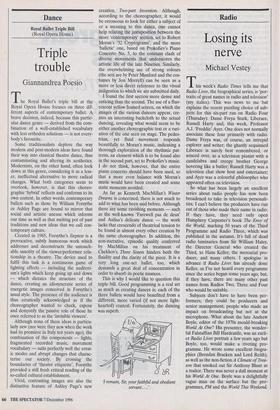Dance
Royal Ballet Triple Bill (Royal Opera House)
Triple trouble
Giannandrea Poesio
The Royal Ballet's triple bill at the Royal Opera House focuses on three dif- ferent aspects of contemporary ballet. A brave decision, indeed, because this partic- ular dance genre — derived from the com- bination of a well-established vocabulary with less orthodox solutions — is not every- body's favourite.
Some traditionalists deplore the way modern and post-modern ideas have found their way into classical theatre dance, thus contaminating and altering its aesthetics. Modernists, on the other hand, often look down at this genre, considering it as a less- er, ineffectual alternative to more radical changes. What both categories seem to overlook, however, is that this choreo- graphic 'hybrid' reflects and conforms to its own context. In other words, contemporary ballets such as those by William Forsythe or Ashley Page are bound to mirror that social and artistic unease which informs our time as well as that melting pot of past traditions and new ideas that we call con- temporary culture.
Created in 1985, Forsythe's Steptext is a provocative, subtly humorous work which addresses and deconstructs the untouch- able sanctity of the viewer/performer rela- tionship in a theatre. The device used to fulfil this task is a continuous game of lighting effects — including the auditori- um's lights which keep going up and down — which dictates the structure of the dance, creating an idiosyncratic series of energetic images conceived in Forsythe's usual style. The presence of the audience is thus erratically acknowledged as if the choreographer wanted to check, expose and demystify the passive role of those he once referred to as the 'invisible viewers'.
Although none of these ideas is particu- larly new (nor were they new when the work had its premiere in Italy ten years ago), the combination of the components — lights, fragmented recorded music, movement vocabulary — suits perfectly well the errat- ic modes and abrupt changes that charac- terise our society. By crossing the boundaries of 'theatre etiquette', Forsythe provided a still fresh critical reading of the so-called cultural establishment.
Vivid, contrasting images are also the distinctive feature of Ashley Page's new creation, Two-part Invention. Although, according to the choreographer, it would be erroneous to look for either a subject of or a meaning to this dance, one cannot help relating the juxtaposition between the more 'contemporary' section, set to Robert Moran's '32 Cryptograms', and the more 'balletic' one, based on Prokofiev's Piano Concerto No. 5, to the constant clash of diverse movements that underscores the artistic life of the late Nineties. Similarly, the overwhelming use of strong colours (the sets are by Peter Munford and the cos- tumes by Jon Morrell) can be seen as a more or less direct reference to the visual indigestion to which we are submitted daily.
I found the first section more dense and enticing than the second. The use of a fluo- rescent yellow framed screen, on which the images of the various dancers appear, cre- ates an interesting backcloth to the actual dancing, revealing what would seem to be either another choreographic text or a vari- ation of the one seen on stage. The pedes- trian, yet fluid movement responds beautifully to Moran's music, indicating a thorough exploration of the rhythmic pat- terns, an element which is to be found also in the second part, set to Prokofiev's music. I do not think, however, that the entire piano concerto should have been used, so that a more even balance with Moran's music would have been created and some static moments avoided.
As far as Kenneth MacMillan's Winter Dreams is concerned, there is not much to add to what has been said before. Although there are some ravishing moments — such as the well-known 'Farewell pas de deux' and Anfisa's delicate dance — the work lacks that crescendo of theatrical tension to be found in almost every other creation by the same choreographer. In addition, the non-narrative, episodic quality conferred by MacMillan on his treatment of Chekhov's Three Sisters hinders both the fluidity and the clarity of the piece. It is a very long one-act ballet, too, which demands a great deal of concentration in order to absorb its poetic nuances.
This is why I would like to question this triple bill. Good programming is a real art as much as creating dances is; each of the three ballets would have benefited from a different, more varied (if not more light- hearted) context. Fortunately, the dancing was superb.
7 remain, Sir, your faithful and obedient servant . .


















































































 Previous page
Previous page